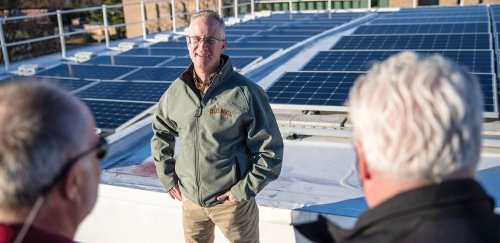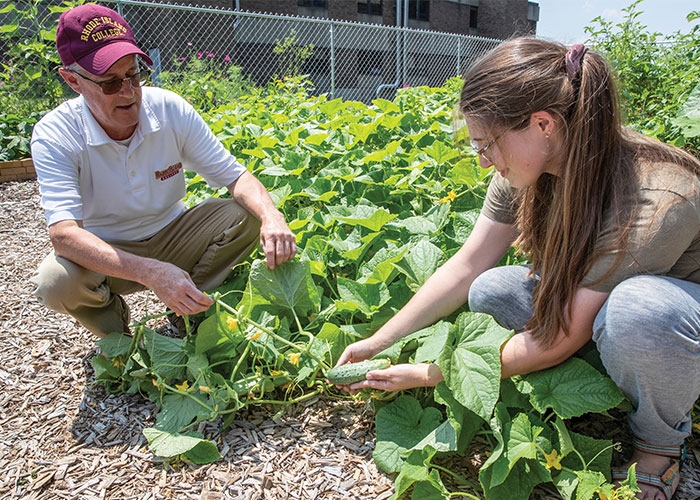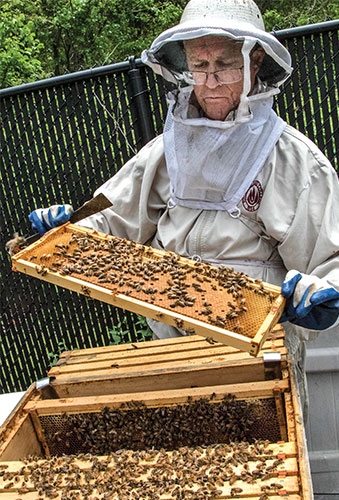
Jim Murphy, RIC sustainability coordinator, stands on the rooftop of Donovan Dining Center, where an array of solar panels now generates electricity for the college.
It’s the little things that add up, says RIC Sustainability Coordinator Jim Murphy – solar panels, a vegetable garden, bee hives, EV charging units, bottle-filling stations – none of these are large-scale projects on their own, but when working in tandem, they do serious good for the planet and the college.
In fact, Rhode Island College is a federally recognized U.S. Department of Education Green Ribbon School. This designation is awarded to schools, districts and institutions of higher education who reduce their environmental impact and costs; improve the health and wellness of their school, students and staff; and provide effective environmental and sustainability education.
Renewable energy company Ameresco performed an audit at Rhode Island College to assess what could be done to make the college more energy efficient. Based on their audit, Murphy began with the easiest, least expensive task. “We switched all of the campus lighting to LED lighting,” he says. “That brought immediate savings. We could then use that savings to leverage other projects.”
RIC had solar panels installed on the roofs of Donovan Dining Center and the Student Union. The total cost of the project was $300,000. One-third of the cost was funded by Rhode Island Commerce and the Rhode Island Office of Energy Resources. RIC’s cost was $100,000. The college is now saving $20,000 a year in electricity. “We can take that $20,000 in savings each year and put it elsewhere,” says Murphy.
“Gaige, Craig-Lee, Alger and Adams Library all have new roofs, where we’d like to place solar panels. Not only will it lower our carbon footprint, it will make us fiscally sound,” he says.
Using outside dollars to make the campus greener is Murphy’s preferred method of getting things done. Last year the college received a grant to cover the full cost of upgrading the college’s EV charging stations.
The college is also working to reduce waste of all kinds on campus. Behind the Fogarty Life Science building is RIC’s very own garden, which quietly yields much of the produce that students find on their trays in the Donovan Dining Center.


Every year Lowe’s Home Improvement donates seeds and equipment. Gotham Greens also donates several starter plants. Basil, banana peppers, chocolate peppers, ground cherries, several different varieties of tomatoes, green beans, strawberries, eggplants and lettuce are just some of the foods grown in RIC’s garden and served on campus. Student volunteers help care for the garden and get first choice of the produce to take back to their dorms. This year the garden yielded approximately 400 pounds of produce.
“Jim’s impressive knowledge and tireless work ethic have been instrumental in achieving Dining Services’ sustainability objectives, including, but not limited to, our Green Restaurant three-star rating, our solar panels, our rooftop apiary and much more,” says Arthur Patrie, director of dining and retail services at the college.
By growing food right on campus as opposed to ordering produce that travels thousands of miles to get here, the college is reducing both the cost and the carbon footprint of the food it serves. Likewise, fresh produce not only tastes better but retains more of its nutritional value.

Rhode Island College has had beehives for 11 years. Much of the beekeeping equipment was paid for by a grant. With four hives at the Bee Education Center on East Campus and more hives on top of Donovan Dining Center that house around 15,000 to 20,000 bees per hive, the bee colony vastly outnumbers people on campus.
Honey created by the bees is used in many Donovan recipes, such as the honey mint balsamic dressing.
But food isn’t the only area in which the college reduces waste and saves money.
“I don’t let anyone throw anything away without me seeing it first,” Murphy says. “We did a remodel of Horace Mann. Rather than throwing a lot of the used classroom and office furniture into the dumpster, we were able to find homes for it at other schools that really needed it in Central Falls and Providence. Not only were we able to avoid the cost of throwing it away, we got it into the hands of people who could really use it.”
Similarly, bottle-filling stations around campus have saved 1.5 million single-use plastic bottles from flooding RIC’s trash stream since their implementation. This has benefited the environment and cut down on the cost of disposing plastic bottles.
Campus sustainability projects often involve many members of the RIC community, not just those working directly in sustainability. “The fun projects are the ones that involve students, faculty and staff,” Murphy says. For instance, all members of the RIC community get involved in the garden and greenhouse. “Professor Roberts from the Biology Department is constantly helping students in the garden,” he notes. “And Pam Hill, who oversees the greenhouse, supplies our starter plants for the garden. The feedback from the campus community has been consistently positive.”
Murphy believes this work will have downstream effects, such as keeping tuition more affordable. “RIC has always been a good option for folks who don’t necessarily have the money to go to college,” he says. “If you’re a student financing your education yourself or borrowing to get a college degree, cost-saving projects like these make that happen. By doing things in a thoughtful manner, I think we succeed at keeping our costs down.”
Looking toward the future, Murphy is preparing for increased and more intense storms and flooding due to climate change.
“We’re making sure the storm drains on campus are clean so that stormwater runoff has a place to go,” he says. “Behind the garden there’s a big dip in the ground that’s capturing all the stormwater runoff from the adjacent parking lot. The ground is naturally absorbing that water so it’s not going into a storm drain and into the bay. Instead, it’s going into places that are growing plants.”
He is also planning more sustainability goals for RIC’s future, like becoming a carbon-free campus. “I’d like to see us as close to net zero as we can be,” he says. “If we had solar panels on every roof and we had a cogeneration system that could shrink our electric bill to tens of thousands instead of hundreds of thousands each month, I’d be really happy.” Surely, he has proven that small changes add up.
